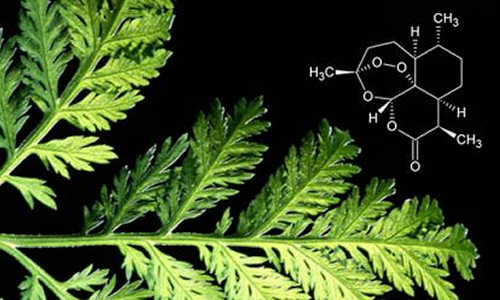Medicine is drifting towards a major problem. An increasing number of bacteria is no longer sensitive to known antibiotics. Doctors urgently need to find new ways of fighting these multi-resistant pathogens. To address the problem, pharmaceutical research is turning back to the source of most of our drugs: nature.
Nature holds the key to new substances against a variety of medical problems. One example is the malaria drug Artemsinin from annual wormwood Artemisia annua. Photo Credit: Keystone / Science Photo Library, Scott Bauer / Montage: ETH Zurich
Although hundreds of thousands of known active agents are found in nature, exactly how most of them work is unclear. A team of researchers from ETH Zurich has now developed a computer-based method to predict the mechanism of action of these natural substances. The scientists hope this method will help them to generate new ideas for drug development. “Natural active agents are usually very large molecules that often can be synthesized only through very laborious processes,” says Gisbert Schneider, a professor of computer-aided drug design at the Institute of Pharmaceutical Sciences at ETH Zurich. An understanding of the exact mechanism of action of a natural substance enables the design of smaller, less complex molecules that are easier to synthesise. Once a substance is chemically synthesised, it can be optimised for medical applications.
In order to understand the mechanism of action, researchers are studying which parts of a pathogen interact with the natural substance to inhibit its growth for example. In the past, this involved highly complex laboratory tests through which scientists usually identified only the strongest effect of a substance. However, this interaction alone is often unable to explain the entire effect of a natural substance. “Minor interactions with other target structures can contribute to the overall effect as well,” explains Schneider.
Analysis of 210,000 natural substances
Using the computer-based method, the researchers led by Gisbert Schneider were able to predict a variety of potential target structures for 210,000 known natural substances. The software uses a trick to do this: instead of starting with the complete, often complex chemical structure of the substance, it breaks it down into small fragments. This process is based on an algorithm that sifts through chemical databases to find potential interaction partners.
The algorithm does not select fragments randomly, but according to the principle of retrosynthetic analysis, a concept that originated in organic chemistry. When chemists want to synthesise a substance, they must consider what intermediate molecules are needed to reach the target. “We wanted to break down the molecules into relevant building blocks,” explains Schneider. The software in turn calculates which individual fragments can be used to theoretically synthesise the substance.
“By using the computer to break down the molecules, which can be quite large, into separate building blocks, we discover which parts might be essential for the mechanism of action,” says Schneider. Thus, it might be possible to design less complex molecules that chemists could synthesise instead of the laborious process of isolating them from the natural source.
Similarities discovered
The researchers tested their method in detail on a substance found in myxobacteria. This substance, known as archazolid A, slows the growth of tumour cells and has a known target structure; however, there is evidence that interaction with other cellular factors must play a role in its anti-tumour effect. The researchers were able to use the software to identify the other factors and then confirm some of these in laboratory experiments. They were surprised to find that the mechanism of action of archazolid A resembles a much smaller, less complex molecule, arachidonic acid, an unsaturated fatty acid. “This example illustrates how a desirable effect can often be achieved using simpler substances as well,” says Schneider. This case could provide inspiration for the development of new drugs.
“The analysis is not yet perfect. We were unable to confirm several of the suggested interactions in biochemical experiments,” Schneider admits. The goal is therefore to optimise the predictive power of the software even further. However, the algorithm has already helped to narrow down the number of possible candidates that may interact with a substance – and thus reduced the effort required for subsequent lab tests to confirm the interactions experimentally. This should make it easier in future to decipher the mechanisms of action of natural substances.
Story Source:
The above story is based on materials provided by ETH Zurich.





